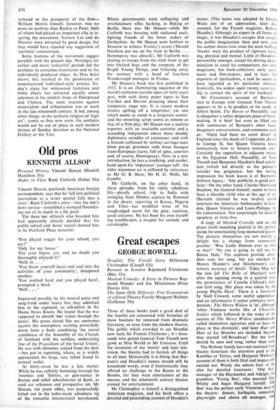Bunthorne's day
LEONEE ORMOND
The Aesthetic Movement: Prelude to A Nouveau Elizabeth Aslin (Elek '100s) 'How cheap even pretty aesthetical effe are—Japanese chintz curtains, mats & ts penny Morris wallpapers, Queen Anne wick chairs, rugs & so forth'. This was written 1882 by Violet Paget (Vernon Lee), who ia just paid a visit to Liberty's, 'the wonder aesthetic shop', where she bought some thin to take home to Italy. Two years later s published a novel, Miss Brown, in which savagely attacked the aesthetic movement decadent and immoral. Such inconsiste was apparently typical. George du Mauri who satirised the aesthetes in Punch, h blue-and-white china, Morris wallpaper a
, a concave mirror in his studio, while W. Gilbert, author of Patience, built himself Queen Anne style house in South K sington.
Miss Aslin's book deals exclusively la those aspects of aestheticism which Vern Lee, du Maurier and Gilbert themseh adopted. It is not concerned with qualities of affectation, maudlin intensit extravagant self-adulation and sheer tat ness which so alarmed the satirists ; in sense, the book is- about the 'art furnit craze, and not about the aesthetic moveme The popularity of antique collecting h created a demand for factual informati which Miss Aslin supplies in a lucid reliable text.
The choice of plates is excellent, rangi over the whole field of 'seventies and 'eigh design. The wallpapers by Lewis F. Day,B Talbert and Walter Crane could well reprinted, and some of the ceramics are `quite too too', as the aesthetes would ha said. One of the more extraordinary items a tea-pot, presumably inspired by Patten which shows a male and a female aesl back to back, the former sporting a lily, latter a sunflower ; a drooping arm forms spout. William de Morgan tiles, E. W. G win furniture, illustrations by Kate G away and Walter Crane and their imitat are given admirable coverage, together so the more obscure examples, like the 1 Christmas cards, 'wishing you an utt charming'. and 'a quite too happy time'.
But if these objects reflect various as of the aesthetic period, they also repr
'very different viewpoints on aesthetic itself, which are not always suffice differentiated. It is important to realise the aesthetes were consumers, not craft and that those articles which they ado as part of their cult do not represent own creative achievement. Their chain ship of Morris wallpapers must have
tributed to the prosperity of the firm— William Morris himself, however, was no more an aesthete than Ruskin or Pater, both of whom had played an important role in in- spiring the movement. Vernon Lee and du Maurier were attracted by good design, but they would have rejected any suggestion of 'aesthetic' commitment.
Some features of the movement suggest parallels with the present day. Nostalgia for earlier and more 'colourful' periods led the aesthetes to conscious historicism and to the individually produced object. As Miss Aslin shows, this resulted in the production of manufactured 'individual-style' articles. To- day's craze for whitewood furniture and rustic chairs has attracted equally astute salesmen in the modish shops of Hampstead and Chelsea. The same reaction against materialism and urbanisation was at work in the late nineteenth century. It led, among other things, to the aesthetic religion of 'high art': comic as they now seem, the aesthetes would not be out of place in such modern shrines of Sunday devotion as the National Gallery or the Tate.



































 Previous page
Previous page